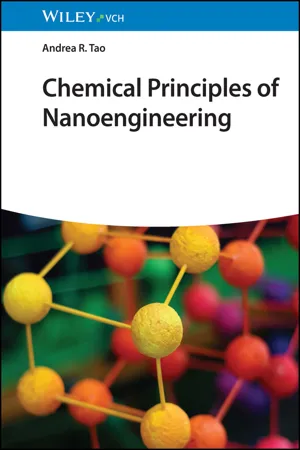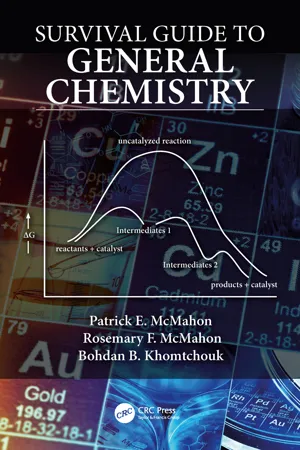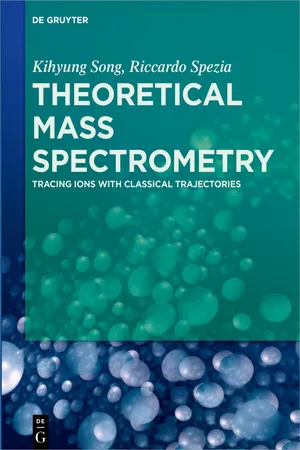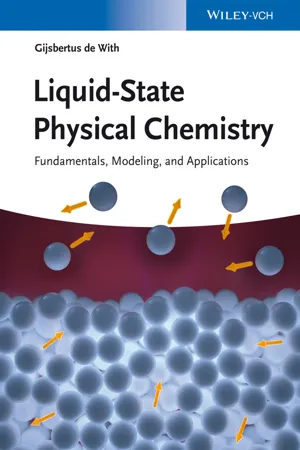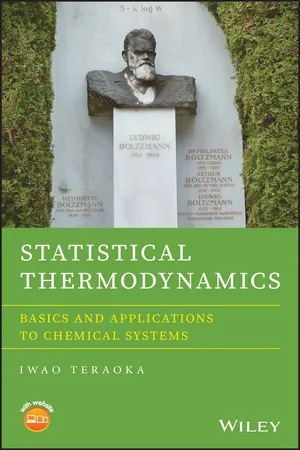Chemistry
Intramolecular Force and Potential Energy
Intramolecular forces are the attractive and repulsive forces between atoms within a molecule. These forces determine the molecule's shape, stability, and physical properties. Potential energy is the energy stored within a molecule due to the arrangement of its atoms and the strength of its intramolecular forces. It is a key factor in understanding chemical reactions and molecular behavior.
Written by Perlego with AI-assistance
Related key terms
Related key terms
1 of 4
Related key terms
1 of 3
11 Key excerpts on "Intramolecular Force and Potential Energy"
- eBook - ePub
Molecular Simulations
Fundamentals and Practice
- Saman Alavi(Author)
- 2020(Publication Date)
- Wiley-VCH(Publisher)
In quantum mechanics, all aspects of the molecular potential energy surface (neglecting magnetic spin effects) originate from electrostatic interactions among electrons and nuclei in the system. In the classical representation, the total potential energy of the system is approximated as a sum of intra‐ and intermolecular contributions, which are described by different functional forms:(3.15)The classical intramolecular potential energy terms are required to maintain proper bond lengths, bond angles, and dihedral angles in the molecule, while at the same time giving the molecule the possibility of some shape flexibility. If these contributions are not modeled correctly, the molecular structure can be distorted in unphysical ways leading to incorrect representations of molecular behavior in the simulation. Classical intramolecular potentials are usually not designed to allow breaking and formation of chemical bonds. During bond breaking and formation, the electronic distributions in the molecule in the vicinity of the affected chemical bond are severely disrupted and the Born–Oppenheimer approximation will no longer hold. Simple classical representations of the atom–atom bond interactions cannot capture these changes.Intermolecular potential energy terms model the interactions between molecules that maintain the proper gas, liquid, or solid physical state of the system at the temperature of the simulation. These interactions are usually modeled as a sum of electrostatic and van der Waals potentials.The total energy in a mechanical system is the sum of the kinetic and potential energies. The average kinetic energy gives a rough measure of the energy available for interconversion to intra‐ or intermolecular potential energy. At relatively low temperatures, say up to 500 K, the average atomic kinetic energy in molar units is shown in Chapter 4 - eBook - ePub
- Andrea R. Tao(Author)
- 2023(Publication Date)
- Wiley-VCH(Publisher)
Intermolecular forces are responsible for these “weak” or secondary bonds that occur between molecules, particles, and surfaces. The bonds that result from intermolecular forces lack specificity, stoichiometry, and directionality. These forces can also result in interactions that occur over long distances – much longer than interatomic bond lengths.As we will see throughout Chapter 1 , intermolecular forces play an important role in dictating materials and molecular behavior at the nanoscale. We will cover five different types of intermolecular forces: electrostatic, hydrogen bonding, van der Waals (vdW ), hydrophobic, and steric forces. For each of these, we will derive and discuss their universal force laws. We will also discuss the differences between these forces for molecules versus nanoscale objects. Finally, we will develop an understanding of how potential energy diagrams can be used to predict the overall intermolecular interactions between two objects as a function of separation distance. This knowledge will be applied toward understanding the behavior of nanosystems ranging from atoms and molecules (e.g. DNA and polymers) to particles and other nanomaterials (e.g. liposomes, metal nanoparticles, C60 ).1.1 The Pairwise Potential
Intermolecular forces can lead to attraction or repulsion between atoms, molecules, particles, and surfaces, and contribute significantly to how nanoscale materials and systems behave. These forces are classified as conservative forces, meaning that they satisfy the relationship:(1.1)where F is the force, V(r) is the potential energy of the object, and r is distance. Because of this relationship, potential energy can be used as a descriptor of whether the force between two objects is attractive or repulsive.We often consider pairwise potentials that describe V(r) as a function of separation distance to determine attraction or repulsion. For example, two possible pairwise potentials between two spherical particles of radius Rsare depicted in Figure 1.2 - eBook - ePub
- Patrick E. McMahon, Rosemary McMahon, Bohdan Khomtchouk(Authors)
- 2019(Publication Date)
- CRC Press(Publisher)
Chapter 3 as visual examples to picture potential energy conversion based on response to a force. The falling boulder represents response to gravity; the analogous relationship depicts response to the electromagnetic force. For the electromagnetic force, opposite charges farther apart represents the higher potential energy position. As opposite charges approach, the decrease in potential energy can be observed as an increase in kinetic energy such as heat.The electromagnetic force is responsible for the energy of chemical bonding. Molecules and compounds store chemical/electrical potential energy through the arrangements of electrons and nuclei relative to each other in chemical covalent or ionic bonds. Chemical potential energy released (or absorbed) through the response to the electromagnetic force during a chemical reaction is caused by rearrangement of atoms and electrons to form new combinations and new bonding/positional relationships.Within the confines of potential and kinetic energy, the law of conservation of energy requires that any change in total potential energy (ΔPE) must be accompanied by an equal and opposite change in the kinetic energy.II CHEMICAL BOND ENERGETICS Recall, as discussed in Chapter 12 , that the potential energy of an electron in an atom is based on the electromagnetic force of attraction to the positively charged nucleus; a greater strength of attractive force is equated to a lower potential energy. The force of attraction is proportional to the size of the positive and negative charges and inversely proportional to the square of the distance between the charges.The strength of the attractive force and the stability of an electron is inversely proportional to the distance of the electron from the nucleus: the closer the electron to the nucleus, the greater the attractive force and thus the lower the potential energy.Electron relationship to the nucleus:The potential energy of a (covalent) chemical bond is based on the arrangements of the bonding electrons to the nuclei of the two bonded atoms. Bonding energy is derived through the electromagnetic force of attraction between both nuclei and the bonding pair of electrons. - eBook - ePub
- Sir Alan Cottrell(Author)
- 2019(Publication Date)
- CRC Press(Publisher)
Chapter 4Chemical Bonding
4.1 Forces between atoms
The physical meaning of chemical affinity is that an attractive force exists between the atoms. There is also a repulsive force at close range which is the basis of the ‘impenetrability’ of matter. The equilibrium spacing of a pair of atoms is that at which these two forces are equal. Because force is rate of change of energy with distance, the energy of interaction of the pair reaches its lowest value at the equilibrium spacing. Quantum mechanics deals directly with energy, not force, and so it is usual to discuss problems of chemical bonding in terms of energy.We bring two atoms together from infinity, having defined their potential energy of interaction as zero at infinity. Little happens and the energy stays near zero until the atoms are within about an atomic spacing of each other. As they move still closer, the attractive force begins to be felt and the potential energy falls, since work is being done by the atoms as they move together under this force. When they get really close, the short-range repulsive force then also comes into play and soon dominates the attractive force. The potential energy rises at this stage since the atoms are now being pushed together. This behaviour is shown in Fig. 4.1 which gives the potential energy due to the attractive (curve a), repulsive (curve b) and total (curve c) forces as a function of the distance between nuclei. The potential energy ‘well’ is deepest at the equilibrium spacing r and its depth D there is equal to the work required to dissociate the atoms completely.Whether a collection of such atoms will form a gas or condense together into a liquid or solid depends both on D (in relation to the temperature and pressure) and on the nature of the forces. Molecular gases can form even when D is large (e.g. H2 , O2 , N2 , CO2 , at room temperature) if the atomic forces show saturation - eBook - ePub
- Jacob N. Israelachvili(Author)
- 2010(Publication Date)
- Academic Press(Publisher)
2 Thermodynamic and Statistical Aspects of Intermolecular Forces2.1 The Interaction of Molecules in Free Space and in a Medium
While this book is not primarily concerned with thermodynamics or statistical mechanics, it is nevertheless appropriate to begin by considering some fundamental thermodynamic and statistical principles without which a mere knowledge of interaction forces will not always be very meaningful. In this chapter we shall introduce a number of simple but important thermodynamic relations and then illustrate how these, when taken together with the strengths of intermolecular forces, determine the properties of a system of many molecules. Analyses of more complex “self-assembling” structures are considered in Part III.At the most basic molecular level we have the interaction potential w (r ) between two molecules or particles. This is usually known as the pair potential or, especially when an interaction takes place in a solvent medium, the potential of mean force . The interaction potential w (r ) is related to the force between two molecules or particles by F = −dw (r )/dr . Since the derivative of w (r ) with respect to distance r gives the force, and thus the maximum work that can be done by the force, w (r ) is often referred to as the free energy or available energy .In considering the forces between two molecules or particles in liquids, several effects are involved that do not arise when the interaction occurs in free space. This is because an interaction in a medium always involves many solvent molecules—that is, it is essentially a many-body interaction . Some of these effects are illustrated in Figure 2.1 and will now be described.- 1. For two solute molecules in a solvent, their pair potential w (r ) includes not only the direct solute-solute interaction energy but also any changes in the solute-solvent and solvent-solvent interaction energies as the two solute molecules approach each other. A dissolved solute molecule can approach another only by displacing solvent molecules from its path (Figure 2.1
- eBook - ePub
- Kihyung Song, Riccardo Spezia(Authors)
- 2018(Publication Date)
- De Gruyter(Publisher)
4 Interaction Energy In order to theoretically describe the collision process and the subsequent energy transfer and (eventually) fragmentation mechanisms, a key step is to describe the interaction energy between the ion and the projectile and of the ion (and the projectile if nonmonoatomic gases are used) itself. The quality and reliability of the subsequent results will (also) depend on the potential used. At this end the total interaction potential is partitioned as V = V ion + V proj + V ion-proj (4.1) where V ion and V proj are the intramolecular potential of the ion and the projectile, respectively, and the V ion–proj is the interaction potential between the ion and the projectile. Note that in the case of setups without a projectile (as in internal energy activation or post-TS dynamics) the total potential ≡ V ion and the discussion holds identical. The use of different forms of interaction potentials is very important in order to define the properties that can be observed and the quality of such properties. We know review the most common kinds of interaction potentials. 4.1 Classical Intramolecular Potential In order to describe the intramolecular potential of extended molecules (first term of equation (4.1)), a possibility is to use an explicit potential defined in terms of bonds, angles and dihedrals, similar to what used in biomolecular simulations [ 161 – 163 ]. In particular, Hase and coworkers have used an Amber potential [ 161 ] to study collisional energy transfer in peptides. [ 10, 164 ] V ion = ∑ bonds K r (r − r e q) 2 + ∑ angels K θ (θ − θ e q) 2 + ∑ dihedrals V n 2 [ 1 − cos (n ϕ − γ) ] + ∑ i > j [ A i j r i j 12 − B i j r i j 6 + q i q j ϵ r i j ] ([--=PLGO-SE - eBook - ePub
Liquid-State Physical Chemistry
Fundamentals, Modeling, and Applications
- Gijsbertus de With(Author)
- 2013(Publication Date)
- Wiley-VCH(Publisher)
3 Basic Energetics: Intermolecular InteractionsAll bonding and molecular interaction characteristics are determined by quantum mechanics. In liquids, we deal mainly with intermolecular forces and these may be described to quite some extent via classical considerations. In this chapter, we describe the long-range electrostatic intermolecular interactions using the multipole expansion. To that we add the induction and the dispersion interactions. In this approach, short-range repulsion, due to orbital overlap, is usually treated in an empirical way. We end with a brief discussion of some often-used model potentials, together with a few remarks on hydrogen bonding and three-body interactions and the virial theorem. For further details, reference should be made to the books in the section “Further Reading” of this chapter, which have been used freely.3.1 Preliminaries
In principle, molecules and their interactions should be described by the Schrödinger equation. As this formidable problem cannot be solved exactly we use approximate methods, and in this chapter we describe some of them for intermolecular interactions. From the Born–Oppenheimer approximation (see Section 2.4) we know that an (effective) potential energy E(r) for the motion of the nuclei with coordinates r exists. In fact, this is the potential energy employed in all of the discussions on intermolecular interactions. To emphasize the fact that E(r) acts as a potential energy, from now on, we label it as Φ(r).Experiments together with quantum mechanics have made clear that all interaction potentials between molecules have a shape, as presented in Figure 3.1 - eBook - ePub
- Mark Brouard, Claire Vallance, Mark Brouard, Claire Vallance(Authors)
- 2015(Publication Date)
- Royal Society of Chemistry(Publisher)
CHAPTER 2 Potential Energy Surfaces: the Forces of Chemistry MATTHEW A. ADDICOAT AND MICHAEL A. COLLINS Research School of Chemistry, Australian National University, Canberra, Australia2.1 INTRODUCTION
The aim of theoretical chemical dynamics is to understand the mechanisms and calculate the rates of chemical reactions. Why? Hopefully, because then we could understand how reactions occur, devise new reactions, and do chemistry more efficiently. What does “mechanism” mean? We might say we understand the mechanism of a reaction if we know where every atom is at each instant during the molecular rearrangement. More realistically, we might say that we know the most probable positions of the atoms and how these change during the reaction. It is important to remember that the atoms in a molecule are always in motion. Thinking in terms of Newton’s laws, we realise that the atoms are moving subject to forces. If the forces are known, we could (in principle) calculate how the atoms move and work out the reaction mechanism. Using some statistical mechanics, we can also calculate the probability that the reaction occurs and what the rate of the reaction would be under conditions of thermal equilibrium.In this chapter, we will look at how we calculate the forces acting on the atoms for reactions in the gas phase. The task is difficult for two reasons: It takes a fair amount of computer time to calculate the forces on the atoms for just one particular arrangement of the atoms (molecular configuration), and there are an enormous number of different molecular configurations relevant to a chemical reaction. As explained in Chapter 1, the forces of chemistry are derived from a function we call the molecular potential energy surface (PES). We begin with a general description of PESs, and finish with how we calculate a PES in practice.2.2 THE BORN-OPPENHEIMER APPROXIMATION
For the purposes of chemistry, we can assume that a molecule is composed of electrons and atomic nuclei. The motion of these particles is completely determined by the molecular Hamiltonian, . This Hamiltonian contains the nuclear kinetic energy, N , the electron kinetic energy, e , the Coulomb attraction of the electrons and nuclei, eN , and the electron-electron, ee , and nuclear-nuclear, NN , Coulomb repulsions. In atomic units (in which e= =m e - eBook - ePub
Statistical Thermodynamics
Basics and Applications to Chemical Systems
- Iwao Teraoka(Author)
- 2019(Publication Date)
- Wiley(Publisher)
3 Energy and InteractionsFor a given chemical system, applying the statistical mechanics starts with writing a function called the partition function. The writing requires that we know the energy of each molecule in the system. We learn in this chapter how to describe and specify the energy of each molecule.In the absence of an applied external field and in the absence of interaction between molecules, the energy of a molecule consists of the energy due to the movement of the molecule as a whole and the energy for the movement of atoms within the molecule. We first use classical mechanics to describe the movements and the kinetic energy. Toward the end of the chapter, we learn quantum‐mechanical methods to describe the kinetic energy. “Classical” means that the movement of a molecule follows Newton's equation of motion. It does not only describe the center‐of‐mass translation but also the rotation and the vibration.In Sections 3.1 and 3.2 , we first consider kinetic energy of atoms and ions and kinetic energy of diatomic molecules, respectively, that do not interact with each other. In Section 3.3 , we look at the energy of polyatomic molecules. Then, in Section 3.4 , we learn different types of interaction between molecules. In these four sections, we rely on classical mechanics. After examining briefly an extensive nature of the interaction in Section 3.5 , we turn to quantum mechanics to describe all the components of the energy in Section 3.6 .3.1 Kinetic Energy and Potential Energy of Atoms and Ions
3.1.1 Kinetic Energy
Consider an atom i isolated from the other atoms. There is no field applied. The energy of the atom consists of the kinetic energy εi,kin= ½mivi2 and the energy of the electron εi,elec:3.1where miis the mass of the atom that moves at velocity vi. Electrons are not excited to higher energy levels unless the temperature is as high as the one on the surface of the sun. We examine this situation in Section 3.6.4 . In practice, εi,elecis a constant, and therefore we do not consider εi,elecin this book, unless otherwise mentioned. The atom is isotropic (no specific orientation), and therefore there is no rotation. Equation (3.1 - eBook - ePub
Foundations for Teaching Chemistry
Chemical Knowledge for Teaching
- Keith S. Taber(Author)
- 2019(Publication Date)
- Routledge(Publisher)
If the temperature of a sample only relates to the kinetic energy and not the potential energy of its constituent particles, then it might be useful to have a term that considers the total energy of the system of particles, be that kinetic or potential. The term thermal energy is sometimes used, but (as this term is sometimes used with other meanings) internal energy is probably a better term.There are important practical consequences here. For example, scalding caused by contact with steam at 100°C can be very serious, as it has much more internal energy than the same amount of water at the same temperature . Again, this topic raises questions about the detail that is appropriate for an introductory treatment, as the scientific model is actually quite subtle as well as being abstract – yet over-simplification (ignoring latent heat and potential energy; treating temperature as a direct measure of internal energy) can have unhelpful consequences for later learning (Taber, 2000b).Molecules do not (only) attract each other
One further complication, where there is a tendency to simplify in order to help learners make sense of the abstract world of atoms, molecules, ions, and so forth, is the idea that these particles stick together because they attract each other, and heating provides the energy to overcome these attractions. This is an idea that students will often be receptive to – but it contains a potentially important omission – as suggested earlier when considering molecular collisions.Consider the following statements:- ■ The 3s electron is bound to a sodium atom because it is attracted towards the atomic nucleus.
- ■ Argon forms a solid at very low temperatures because the molecules are attracted to each other.
- ■ The bonds in molecules are attractions between the atomic nuclei and bonding electrons.
- ■ An ion in aqueous solution is solvated because a number of water molecules are attracted to it.
- ■ A metal structure is the result of the attractions between the atomic cores and the delocalised conduction electrons.
At one level these are all very reasonable statements. However, they can give a false impression. These situations are actually equilibria – a structure is stable because the internal forces are balanced. So, in the stable structure, any attractive forces are countered by repulsive forces of equal magnitude. - Sture Nordholm, Jan Forsman, Cliff Woodward, Ben Freasier, Zareen Abbas, Robert Penfold(Authors)
- 2018(Publication Date)
- Elsevier(Publisher)
Chapter 4Intermolecular Potentials
Abstract
We highlight the need for intermolecular potentials which describe the character of the fluid under study. We also consider the means of generating these potentials, which will allow us to describe the properties of real fluids. We confine ourselves to the use of pairwise intermolecular interactions and describe a ladder of generic potentials starting with the hard-sphere interaction which accounts for steric size, Lennard-Jones potentials which include attractions, and finally a number of simple fluid pair potentials allowing independently determined ranges of attraction and repulsion. Low order electrostatic interactions including ion–ion, ion–dipole, dipole–dipole, ion–induced dipole and dispersion attraction are then described. The mapping of such orientation-dependent potentials onto simple fluid form by an “effective potential” scheme is presented. Such effective potentials account for orientational correlations and corresponding entropy reduction by thermal effects,. We end with a discussion of the common practice in fluid simulations of describing intermolecular potentials in terms of partial charges located at atomic centers combined with Lennard-Jones potentials acting between at least some of the nonbonded atoms.u( T ; r )e f fKeywords
Pair-potential; Many-body effect; Hard-sphere potential; Lennard-Jones potential; Electrostatic potentials; Induction effect; Correlation; Dispersion; Effective potential; Partial charges4.1 Intermolecular Potential Types
The application of statistical mechanics to real molecular fluids requires potentials of interactions. Thus one could say that the problem at hand consists of two tasks:- ■ Determine the appropriate interaction potential;
- ■ Set up the partition function and extract from it the desired equilibrium properties.
It is possible to justify working nearly entirely on only one of these two important tasks. For realistic and accurate treatments, both are quite difficult enough to absorb entire subcommunities of scientists. Traditionally, the field of statistical mechanics has been more concerned with the ways and means to obtain thermodynamic properties of well defined models by analytical or numerical methods than about producing accurate interaction potentials. The reason is that, firstly, many of the most important applications, systems and thermodynamic properties have depended mainly on gross features of the potentials rather than their details. For example, witness the enormously useful applications of the ideal gas law [1 ,2]
Index pages curate the most relevant extracts from our library of academic textbooks. They’ve been created using an in-house natural language model (NLM), each adding context and meaning to key research topics.
Explore more topic indexes
Explore more topic indexes
1 of 6
Explore more topic indexes
1 of 4

